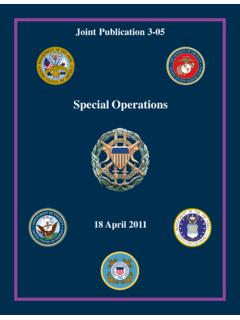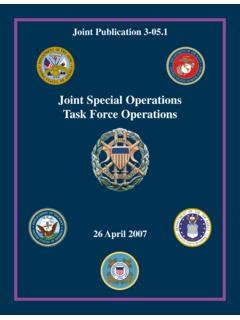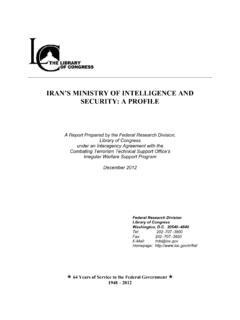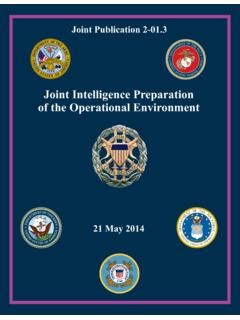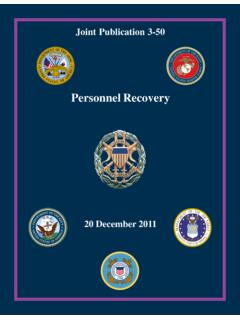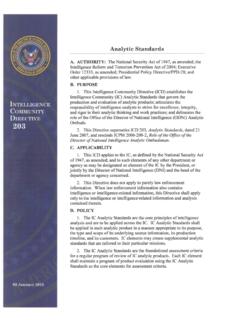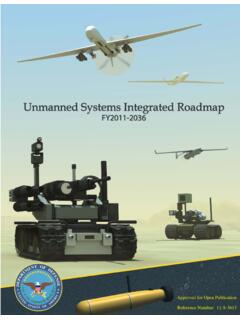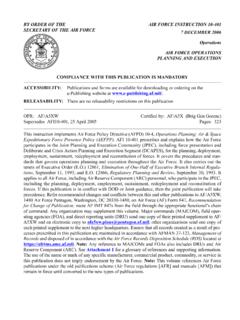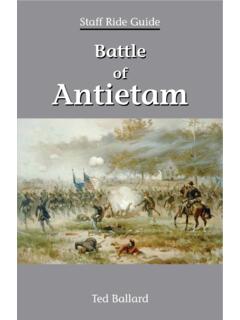Transcription of Ranger Handbook - Federation of American Scientists
1 SH 21-76 UNITED STATES ARMY Ranger Handbook Not for the weak or fainthearted Ranger TRAINING BRIGADE UNITED STATES ARMY INFANTRY SCHOOL FORT BENNING, GEORGIA JULY 2006 i Ranger CREED Recognizing that I volunteered as a Ranger , fully knowing the hazards of my chosen profession, I will always endeavor to uphold the prestige, honor, and high esprit de corps of the Rangers. Acknowledging the fact that a Ranger is a more elite Soldier who arrives at the cutting edge of battle by land, sea, or air, I accept the fact that as a Ranger my country expects me to move further, faster, and fight harder than any other soldier. Never shall I fail my comrades I will always keep myself mentally alert, physically strong, and morally straight and I will shoulder more than my share of the task whatever it may be, one hundred percent and then some. Gallantly will I show the world that I am a specially selected and well trained Soldier. My courtesy to superior officers, neatness of dress, and care of equipment shall set the example for others to follow.
2 Energetically will I meet the enemies of my country. I shall defeat them on the field of battle for I am better trained and will fight with all my might. Surrender is not a Ranger word. I will never leave a fallen comrade to fall into the hands of the enemy and under no circumstances will I ever embarrass my country. Readily will I display the intestinal fortitude required to fight on to the Ranger objective and complete the mission, though I be the lone survivor. STANDING ORDERS, ROGERS' RANGERS 1. Don't forget nothing. 2. Have your musket clean as a whistle, hatchet scoured, sixty rounds powder and ball, and be ready to march at a minute's warning. 3. When you're on the march, act the way you would if you was sneaking up on a deer. See the enemy first. 4. Tell the truth about what you see and what you do. There is an army depending on us for correct information. You can lie all you please when you tell other folks about the Rangers, but don't never lie to a Ranger or officer.
3 5. Don't never take a chance you don't have to. 6. When we're on the march we march single file, far enough apart so one shot can't go through two men. 7. If we strike swamps, or soft ground, we spread out abreast, so it's hard to track us. 8. When we march, we keep moving till dark, so as to give the enemy the least possible chance at us. 9. When we camp, half the party stays awake while the other half sleeps. 10. If we take prisoners, we keep' em separate till we have had time to examine them, so they can't cook up a story between' em. 11. Don't ever march home the same way. Take a different route so you won't be ambushed. 12. No matter whether we travel in big parties or little ones, each party has to keep a scout 20 yards ahead, 20 yards on each flank, and 20 yards in the rear so the main body can't be surprised and wiped out. 13. Every night you'll be told where to meet if surrounded by a superior force. 14. Don't sit down to eat without posting sentries. 15. Don't sleep beyond dawn.
4 Dawn's when the French and Indians attack. 16. Don't cross a river by a regular ford. 17. If somebody's trailing you, make a circle, come back onto your own tracks, and ambush the folks that aim to ambush you. 18. Don't stand up when the enemy's coming against you. Kneel down, lie down, hide behind a tree. 19. Let the enemy come till he's almost close enough to touch, then let him have it and jump out and finish him up with your hatchet. --MAJOR ROBERT ROGERS, 1759 Ranger HISTORY The history of the American Ranger is a long and colorful saga of courage, daring and outstanding leadership. It is a story of men whose skills in the art of fighting have seldom been surpassed. Only the highlights of their numerous exploits are told here. Rangers primarily performed defensive missions until Benjamin Church s Company of Independent Rangers from Plymouth Colony proved successful in raiding hostile Indians during King Phillip s War in 1675. In 1756, Major Robert Rogers, a native of New Hampshire, recruited nine companies of American colonists to fight for the British during the French and Indian War.
5 Ranger techniques and methods of operation were an inherent characteristic of the American frontiersmen; however, Major Rogers was the first to capitalize on them and incorporate them into the fighting doctrine of a permanently organized fighting force. The method of fighting used by the first Rangers was further developed during the Revolutionary War by Colonel Daniel Morgan, who organized a unit known as Morgan s Riflemen . According to General Burgoyne, Morgan s men were ..the most famous corps of the Continental Army, all of them crack shots. Francis Marion, the Swamp Fox, organized another famous Revolutionary War Ranger element known as Marion s Partisans. Marion s Partisans, numbering anywhere from a handful to several hundred, operated both with and independent of other elements of General Washington s Army. Operating out of the Carolina swamps, they disrupted British communications and prevented the organization of loyalists to support the British cause, substantially contributing to the American victory.
6 The American Civil War was again the occasion for the creation of special units such as Rangers. John S. Mosby, a master of the prompt and skillful use of cavalry, was one of the most outstanding Confederate Rangers. He believed that by resorting to aggressive action he could compel his enemies to guard a hundred points. He would then attack one of the weakest points and be assured numerical superiority. With America s entry into the Second World War, Rangers came forth to add to the pages of history. Major William O. Darby organized and activated the 1st Ranger Battalion on June19, 1942 at Carrickfergus, North Ireland. The members were all hand-picked volunteers; 50 participated in the gallant Dieppe Raid on the northern coast of France with British and Canadian commandos. The 1st, 3rd, and 4th Ranger Battalions participated with distinction in the North African, Sicilian and Italian campaigns. Darby s Ranger Battalions spearheaded the Seventh Army landing at Gela and Licata during the Sicilian invasion and played a key role in the subsequent campaign which culminated in the capture of Messina.
7 They infiltrated German lines and mounted an attack against Cisterna, where they virtually annihilated an entire German parachute regiment during close in, night, bayonet, and hand-to-hand fighting. The 2nd and 5th Ranger Battalions participated in the D-Day landings at Omaha Beach, Normandy. It was during the bitter fighting along the beach that the Rangers gained their official motto. As the situation became critical on Omaha Beach, the division commander of the 29th Infantry Division stated that the entire force must clear the beach and advance inland. He then turned to Lieutenant Colonel Max Schneider, Commander of the 5th Ranger Battalion, and said, Rangers, lead the way. The 5th Ranger Battalion spearheaded the breakthrough and thus enabled the allies to drive inland away from the invasion beaches. The 6th Ranger Battalion, operating in the Pacific, conducted Ranger type missions behind enemy lines which involved reconnaissance and hard-hitting, long-range raids. They were the first American contingent to return to the Philippines, destroying key coastal installations prior to the invasion.
8 A reinforced company from the 6th Ranger Battalion formed the rescue force which liberated American and allied prisoners of war from the Japanese prison camp at Cabanatuan. Another Ranger -type unit was the 5307th Composite Unit (Provisional), organized and trained as a long-range penetration unit for employment behind enemy lines in Japanese occupied Burma. The unit commander was brigadier General (later Major General) Frank D. Merrill. Its 2,997 officers and men became popularly known as Merrill s Marauders. The men composing Merrill s Marauders were volunteers from the 5th, 154th, and 33rd Infantry Regiments and from other Infantry regiments engaged in combat in the southwest and South Pacific. These men responded to a call from then Chief of Staff, General George C. Marshall, for volunteers for a hazardous mission. These volunteers were to have a high state of physical ruggedness and stamina and were to come from jungle-trained and jungle-tested units. Prior to their entry into the Northern Burma Campaign, Merrill s Marauders trained in India under the overall supervision of Major General Orde C.
9 Wingate, British Army. There, they were trained from February to June 1943 in long-range penetration tactics and techniques of the type developed and first employed by General Wingate. The operations of the Marauders were iii closely coordinated with those of the Chinese 22nd and 38th Divisions in a drive to recover northern Burma and clear the way for the construction of Ledo Road, which was to link the Indian railhead at Ledo with the old Burma Road to China. The Marauders marched and fought through jungle and over mountains from Hukwang Valley in northwest Burma to Myitkyina and the Irrawaddy River. In 5 major and 30 minor engagements, they met and defeated the veteran soldiers of the Japanese 18th Division. Operating in the rear of the main force of the Japanese, they prepared the way for the southward advances of the Chinese by disorganizing supply lines and communications. The climax of the Marauder s operations was the capture of Myitkyina Airfield, the only all-weather strip in northern Burma.
10 This was the final victory of Merrill s Marauders, which disbanded in August 1944. Remaining personnel were consolidated into the 475th Infantry Regiment, which fought its last battle on February 3, and 4,1945, at Loi-Kang Ridge, China. This Infantry Regiment would serve as the forefather of today s 75th Ranger Regiment. Shortly after the outbreak of the Korean War in June 1950, the 8th Army Ranger Company was formed of volunteers from American units in Japan. The Company was trained in Korea and distinguished itself in combat during the drive to the Yalu River, performing task force and spearhead operations. In November 1950 during the massive Chinese intervention, this small unit, though vastly outnumbered, withstood five enemy assaults on its position. In September 1950, a Department of the Army message called for volunteers to be trained as Airborne Rangers. In the 82nd Airborne Division, five thousand regular Army paratroopers volunteered, and from that number nine hundred men were selected to form the initial eight Airborne Ranger Companies.
